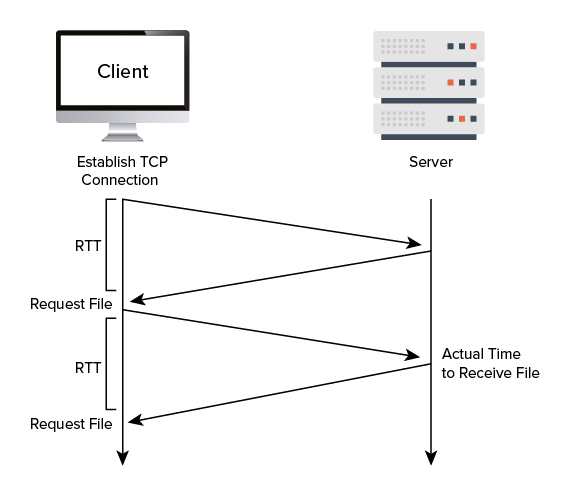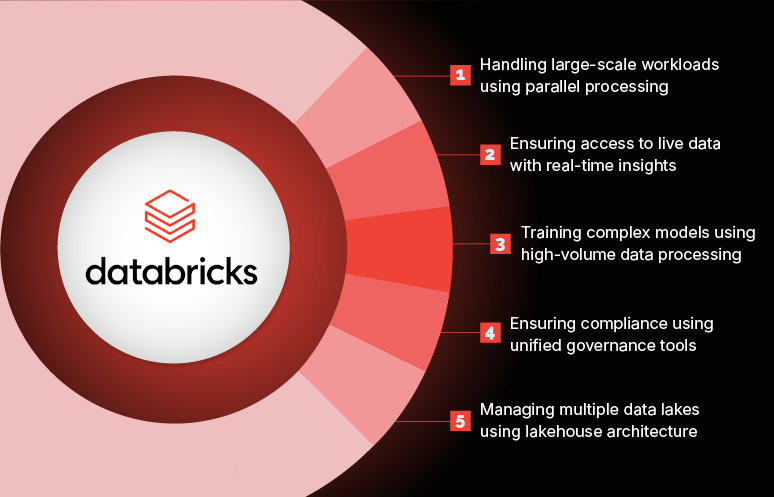Round-trip time (RTT) stands as a pivotal metric for networking and system performance. It encloses the time taken for a data packet to travel from its source to its destination and backward. This measurement is significant for determining the responsiveness and efficiency of communication channels within a network infrastructure.
RTT measures the latency in transmitting data across networks. It comprises transmission time, delay, and processing time at both ends of the communication. A lower RTT denotes faster data transfer and seamless interactions. This is crucial for applications that require real-time responsiveness, like online gaming, video conferencing, and financial transactions. This makes it imperative for organizations to reduce RTT.
In this blog we will explore the intricacies of RTT, explaining its significance in network performance optimization. We will also explore actionable strategies and best practices that will help reduce RTT and enhance user experiences and operational efficiencies across digital ecosystems.
The significance of RTT in networking
As we discussed above, RTT is crucial to networking and has a significant impact on user experience and system performance. Comprehending the significance of RTT reveals the fundamental principles of effective data transfer and network agility.
RTT is important for more than just individual transactions; it affects the overall scalability, dependability, and efficiency of the network. High RTT values can result in poor user experiences, higher packet loss, and slow performance. On the other hand, throughput, quality of service (QoS), and network resilience are all increased when RTT is optimized.
RTT is crucial for networking environments because it helps to optimize data flow, guarantee uninterrupted connectivity, and create strong digital ecosystems. Gaining an understanding of RTT’s complexities enables enterprises to improve network performance, proactively handle latency issues, and provide outstanding user experiences.
Importance of having RTT less than 100ms
Low RTT values signify that data travels swiftly between endpoints, leading to faster response times for applications and a smoother user experience. Conversely, high RTT values can cause delays and sluggish performance.
RTT (Round Trip Time) Measurement
Measuring RTT
Measuring and computing RTT are essential elements in evaluating network performance and enhancing data transfer. Knowing the precise measurement and computation of RTT enables enterprises to detect latency problems, optimize network setups, and improve overall system performance.
There are many tools and methods available for measuring RTT, and each one provides insights into a different aspect of network performance and latency. RTT measurement frequently makes use of ping commands, network monitoring software, and specialized diagnostic tools. By starting data packet exchanges between the source and destination locations, these tools measure how long it takes for packets to finish their round journeys.
To calculate RTT, we must examine how much time passes between the sending and receiving of packets and account for processing times, network propagation delays, and other latency factors.
The RTT calculation formula is simple to use:
RTT = Time of arrival (TOA) – Time of departure (TOD)
Where:
- Time of arrival (TOA): The timestamp when the data packet reaches its destination.
- Time of departure (TOD): The timestamp when the data packet was sent from its source.
Factors influencing RTT and how to solve them:
| Factor | Influence | Solution |
|---|---|---|
| Network congestion | High network traffic and congestion causes delays in data packet transmission and processing and impacts RTT. | We can implement congestion control mechanisms and load balancing strategies to improve congestion-related latency problems. |
| Physical distance | The geographical distance between network endpoints contributes to RTT, with longer distances typically resulting in higher latency. | By leveraging content delivery networks (CDNs) and optimizing routing paths, we can minimize data travel distances and reduce RTT. |
| Network infrastructure | The quality and efficiency of network components, including routers, switches, and cables, influence RTT. | We must upgrade hardware, optimize network configurations, and implement quality of service (QoS) policies to mitigate infrastructure-related latency. |
| Protocol overhead | The protocols used for data transmission, such as TCP/IP, introduce overheads that affect RTT. | Fine-tune protocol parameters, optimize packet sizes, and implement protocol optimizations to enhance data transfer efficiency and reduce RTT. |
| Packet loss and retransmissions | Packet loss and subsequent retransmissions contribute to RTT, especially in unreliable network environments. | Employ error detection and correction mechanisms, along with packet loss mitigation strategies to minimize RTT fluctuations that are caused by lost or retransmitted packets. |
| Network jitter | Network jitter impacts RTT consistency. | Implement jitter buffering, prioritize traffic, and optimize network paths to mitigate jitter-related latency and stabilize RTT measurements. |
| Server performance | The responsiveness and processing capabilities of servers at both ends of the communication affect RTT. | Optimize server configurations, leverage caching mechanisms, and deploy edge computing solutions to reduce server-side latency and improve RTT. |
Strategies for reducing round-trip time (RTT)
1. Optimize network configuration: Fine-tuning network configurations, including routing protocols, quality of service (QoS) settings, and network topologies, reduces RTT by optimizing data transmission paths and minimizing packet routing delays.
2. Implement content delivery networks (CDNs): Leveraging CDNs distributes content closer to end users, reducing data travel distances and lowering RTT. CDNs cache content, optimize delivery routes, and mitigate latency, enhancing overall network performance.
3. Utilize caching mechanisms: Implementing caching mechanisms at strategic points within the network reduces RTT by serving frequently accessed content locally. Caching minimizes data retrieval times, alleviates server load, and improves data access speeds.
4. Deploy edge computing solutions: Edge computing brings computing resources closer to users, reducing RTT by minimizing data travel distances and processing latency. Edge servers process data locally, enhancing real-time responsiveness and reducing dependency on centralized servers.
5. Optimize protocol parameters: Fine-tuning protocol parameters, such as TCP window size, packet size, and congestion control algorithms, optimizes data transfer efficiency and reduces RTT. Protocol optimizations mitigate overheads and improve overall network responsiveness.
6. Implement packet loss mitigation strategies: Addressing packet loss issues through error detection and correction mechanisms, packet retransmission strategies, and network redundancy reduces RTT fluctuations caused by lost or delayed packets.
7. Leverage quality of service (QoS) policies: Prioritizing critical traffic, implementing traffic shaping policies, and managing bandwidth allocation through QoS policies improve RTT for mission-critical applications. QoS optimizations ensure timely delivery of high-priority data, minimizing latency and ensuring consistent performance.
8. Upgrade network infrastructure: Investing in modern networking hardware, upgrading bandwidth capacity, and optimizing network components enhance data transmission speeds, reduce congestion-related delays, and lower RTT.
Suggested: Why AWS is the right choice for your data and analytics needs?
Reducing RTT with Amazon CloudFront
Amazon CloudFront CDN (Content Delivery Network) emerges as a powerful solution for reducing round-trip time (RTT) and optimizing data delivery across distributed networks. Leveraging CloudFront’s global edge locations, caching capabilities, and efficient content routing mechanisms significantly enhances network performance and user experiences.
1. Edge location optimization: Amazon CloudFront operates through a network of edge locations strategically positioned worldwide. By caching content at these edge locations, CloudFront minimizes RTT by serving content from the nearest edge server, reducing data travel distances and latency.
2. Content caching: CloudFront’s caching functionality accelerates content delivery by caching frequently accessed content at edge locations. This caching mechanism reduces RTT for subsequent requests, improves data access speeds, and mitigates server load, enhancing overall system responsiveness.
3. Dynamic content acceleration: CloudFront’s dynamic content acceleration capabilities optimize RTT for dynamic content by leveraging smart caching strategies and efficient content routing algorithms. This ensures fast and reliable delivery of dynamic web content, minimizing latency for real-time interactions.
4. Global content distribution: Amazon CloudFront’s global reach enables organizations to deliver content to users worldwide with minimal RTT. By distributing content across multiple edge locations, CloudFront ensures low-latency access for users across diverse geographical regions.
5. Integration with AWS Services: CloudFront seamlessly integrates with various AWS services, including Amazon S3, EC2, and Lambda, enhancing scalability, reliability, and performance optimization. Organizations can leverage CloudFront’s integration capabilities to deliver content efficiently and reduce RTT for dynamic and static content alike.
6. Edge computing capabilities: Amazon CloudFront offers edge computing capabilities through AWS Lambda@Edge, enabling organizations to execute custom code at edge locations. This facilitates real-time processing and customization of content, further reducing RTT and improving user experiences.
7. Network optimization: CloudFront employs advanced network optimization techniques, including TCP optimizations, route optimizations, and smart content delivery algorithms, to minimize RTT and ensure fast, reliable data delivery.
Suggested: On-premises to AWS cloud migration: Step-by-step guide
Optimize RTT for enhanced network performance!
Understanding round-trip time (RTT) and implementing strategies to reduce it are paramount for optimizing network performance, enhancing data delivery speeds, and ensuring seamless user experiences. RTT, as a measure of latency in data transmission, directly impacts the responsiveness and efficiency of communication channels within network infrastructures.
By accurately measuring and calculating RTT, organizations gain insights into network latency dynamics, identify bottlenecks, and implement targeted strategies to reduce RTT and optimize data transmission pathways. Softweb Solutions offers expert assistance in CDN implementation, network optimization, edge computing, and performance monitoring to reduce RTT and enhance network performance for businesses, ensuring superior user experiences. To know more about how to minimize RTT, please contact our AWS consultants.




